|
|
|
Sort Order |
|
|
|
Items / Page
|
|
|
|
|
|
|
| Srl | Item |
| 1 |
ID:
164373
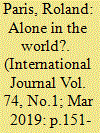

|
|
|
|
|
| Summary/Abstract |
Canada has found itself in serious diplomatic disputes over the past year with Saudi Arabia and China. The Saudis took issue with the Canadian foreign minister’s call to release human rights activists from prison, whereas China was angry at Canada’s arrest of a senior Chinese executive on an extradition request from the United States. These incidents should not be viewed as isolated aberrations. Authoritarian regimes seem increasingly emboldened to lash out at countries that displease them, including allies of the United States. But Ottawa has succeeded in rallying considerable international support for its position in the China dispute, suggesting that while Canada may be exposed, it is not destined to be alone
|
|
|
|
|
|
|
|
|
|
|
|
|
|
|
|
| 2 |
ID:
173268
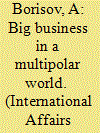

|
|
|
|
|
| Summary/Abstract |
THE 20TH CENTURY went down in history as a century of ideologies and sharp confrontation of states belonging to different systems, the Soviet Union and the United States in the first place. The 21st century has already demonstrated a mounting geopolitical confrontation of great powers that drew international business interests into their whirlpool. It turned out that the main actors of world politics cannot agree on new principles of economic cooperation, free competition and respect for the spheres of interests - they have chosen the road of mounting worldwide tension.
|
|
|
|
|
|
|
|
|
|
|
|
|
|
|
|
| 3 |
ID:
189288
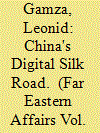

|
|
|
|
|
| Summary/Abstract |
This article analyzes China's technological development as the main strategic component of the reform policy and the basis for the formation of a new model of the country's development. The paper considers the status and structure of China's digital economy and the main areas of its development in the new era. The example of the multinational company (MNC) Huawei, the world leader in advanced information and communication technologies, shows the status, trends, and prospects for the promotion of Chinese technologies in the format of building the Digital Silk Road (DSR) project. The status and peculiarities of the formation of regional segments of the Digital Silk Road are considered, with special reference to individual countries and regions. We emphasize that in the context of the pandemic, the tightening of US sanctions, and the effective blockade of the US market, the digital economy of China has become the core and the basis for the formation of the DSR. The Southeast Asian regional segment close to China is dynamically developing in this direction. The countries of the Middle East and Latin America have considerable potential for cooperation.
|
|
|
|
|
|
|
|
|
|
|
|
|
|
|
|
| 4 |
ID:
171887
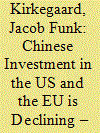

|
|
|
|
|
| Summary/Abstract |
ince peaking in 2016, Chinese outward investment, primarily to the US but also to the European Union (EU), has declined dramatically, especially in response to changes in China’s domestic rules for capital outow. Concern over growing Chinese inuence in other economies, the ascendant role of a Communist Party-led government in Beijing and the possible security implications of Chinese dominance in the high-tech sector have put Chinese outward investment under international scrutiny. This paper analyzes the recent trends in Chinese investment in the US and the EU and reviews recent political and regulatory changes both have adopted toward Chinese inward investment. It also explores the emerging transatlantic difference in the regulatory response to the Chinese information technology rm, Huawei. Concerned about national security and as part of the ongoing broader trade friction with China, the US has cracked down far harder on the company than the EU.
|
|
|
|
|
|
|
|
|
|
|
|
|
|
|
|
| 5 |
ID:
178738
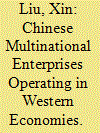

|
|
|
|
|
| Summary/Abstract |
Huawei serves as a vehicle for presenting the multiple barriers faced by Multinational Enterprises (MNEs) that happen to be born in China, a non-democratic and non-Western country who now challenges the world’s No.1 superpower, thus requires a multi-disciplinary analytical framework by taking much broader contexts into considerations. This comparative case study of its operations in the US and UK aims to develop the old model of examining Chinese MNEs that is heavily economic factor focused by including more variables, such as ‘bilateral relations’, ‘law’, ‘media influence’ and ‘cultural proximity’ under host country factors, and ‘governance structure’ under home country factors. The new model will show the increasing complexity in the global competitive landscape and inspire more research to further advance understanding of this new international business phenomenon.
|
|
|
|
|
|
|
|
|
|
|
|
|
|
|
|
| 6 |
ID:
102719
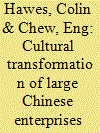

|
|
|
|
|
| Publication |
2011.
|
| Summary/Abstract |
The Chinese government has recently introduced a policy requiring all large Chinese business corporations to transform their corporate cultures with the aim of increasing their competitiveness on the international stage. This paper traces the origins of the policy to the outstanding performance of a small number of Chinese firms since the late 1980s, a phenomenon attributed by the CEOs of these firms to effective implementation of cultural values change among their workforces. We give detailed accounts of two such firms, Haier Group and Huawei Technologies, demonstrating how they have utilized cultural management techniques to improve their employees' performance. We also identify some negative aspects of their approach to cultural management that may impede these firms in their efforts to become truly international corporations.
|
|
|
|
|
|
|
|
|
|
|
|
|
|
|
|
| 7 |
ID:
190851
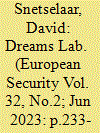

|
|
|
|
|
| Summary/Abstract |
Amid concerns over the rivalry between Washington and Beijing, the discourse and practice of knowledge security have become prevalent in Europe. This is especially true with regard to Sino-Western research collaborations on emerging technologies. Despite the scientific and economic benefits, these collaborations are increasingly perceived as a potential threat in the context of broader concerns with so-called hybrid threats. Knowledge security has emerged as a key term to identify and mitigate the risk of espionage, unwanted knowledge transfers, censorship, and the misuse of dual-use technology. To understand knowledge security and its implications, the article offers a qualitative, in-depth case study of Dreams Lab in the Netherlands: an AI research project run by the University of Amsterdam and the Free University of Amsterdam and funded by the Chinese company Huawei. Li’s practices of assemblage are used as an analytical framework to answer the question: how and why a diverse group of actors were brought together to respond to Dreams Lab and govern scientific knowledge on emerging technologies? By analysing the discourse and practice of knowledge security, the article offers crucial insights into how the great power rivalry is shaping scientific research and the international exchange of knowledge and technology.
|
|
|
|
|
|
|
|
|
|
|
|
|
|
|
|
| 8 |
ID:
177624
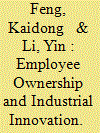

|
|
|
|
|
| Summary/Abstract |
Huawei Technologies, the Chinese telecommunication technology giant that was put into the U.S. government's Entity List from May 2019, has become a contested issue in the emerging U.S.-China technology rivalry. In particular, the U.S. government and Western academics have viewed Huawei's unique employee ownership as an opaque structure subject to the influence of the Chinese state. In this article, we draw on a variety of data sources, including historical archives, interviews with corporate executives, and official government data, to provide a full account of Huawei's employee ownership, including its history, structure, and function. We examine popular misconceptions of Huawei's innovative capabilities and corporate structure, showing that these arguments have generally lacked awareness of the innovation process and corporate governance in the historical context of China's reform. Based on a theory of innovative enterprise, we provide an explanation on how employee ownership has helped Huawei to incentivize a massive engineering workforce and build an innovative organization to succeed in the competitive high-tech industries.
|
|
|
|
|
|
|
|
|
|
|
|
|
|
|
|
| 9 |
ID:
180696
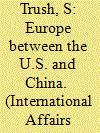

|
|
|
|
|
| Summary/Abstract |
THE CONFLICT between the United States and the People's Republic of China is increasingly taking on a systemic and, in a certain historical perspective, irreversible character. It unfolds not only in the economic, geopolitical, military, technological, and humanitarian dimensions of the bilateral relations, but also in the civilizational dimension. In addition to forming a storyline for Hollywood blockbusters, the hatred of everything Chinese in the United States, currently still focused on the "red-Chinese," also actively penetrates the university milieu. With a little help from Donald Trump's political strategists, the COVID-19 pandemic, which has affected almost every state, has become a "China virus."
|
|
|
|
|
|
|
|
|
|
|
|
|
|
|
|
| 10 |
ID:
169367
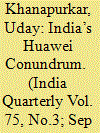

|
|
|
|
|
| Summary/Abstract |
Huawei, the Chinese telecom giant, has emerged as a key player in the provision of infrastructure required to support 5G wireless networks, the adoption of which will be foundational to recipient countries’ deployment of emerging technologies such as artificial intelligence and the Internet of things. At the same time, however, security concerns with respect to Huawei’s ties to the Chinese army and state abound, prompting a number of countries to ban the company from supplying them said telecom infrastructure. India, however, is on the fence in this regard. This article assesses India’s Huawei conundrum through a conceptual framework of economic dependence wherein the costs of a ban and willingness to ban are examined in detail. It is argued that since the expected costs of banning Huawei equipment and the security risks of using them are both substantially high, India’s course of action must be to defer a quick decision and bargain for benefits and assurances.
|
|
|
|
|
|
|
|
|
|
|
|
|
|
|
|
| 11 |
ID:
143382
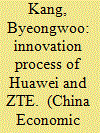

|
|
|
|
|
| Summary/Abstract |
This study compares the innovation process of Huawei and ZTE in China using their patent data. By using patent statistics and raw data, this study provides more detailed findings than what statistics alone can provide. Huawei and ZTE were selected for this study mainly because they were the only Chinese firms that ranked among the top 100 PCT applicants in 2011. This study investigates the difference in the innovation process in R&D between Huawei and ZTE by analyzing (1) domestic and international patent application patterns, (2) granted patents, (3) co-applicants and inventors, (4) knowledge accumulation inside Huawei and ZTE, and (5) knowledge spillover to domestic and foreign firms.
|
|
|
|
|
|
|
|
|
|
|
|
|
|
|
|
| 12 |
ID:
188477
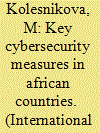

|
|
|
|
|
| Summary/Abstract |
THE SECURITY of the Internet and telecommunications networks has been an increasing national security concern for most nations in recent years, due to the development of 5G and Internet of Things (IoT) technologies, the digitalization of a whole range of governmental and commercial services, the surging popularity of various online services largely because of the COVID-19 pandemic, and the mounting scale of cybercrime, including phishing attacks and financial fraud.
|
|
|
|
|
|
|
|
|
|
|
|
|
|
|
|
| 13 |
ID:
188806
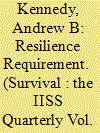

|
|
|
|
|
| Summary/Abstract |
The United States and its partners have arrived at a critical crossroads in their relations with China – and with one another – in the realm of high technology. Some degree of high-tech decoupling between the two sides is already under way, and recent events suggest this trend is accelerating. Combined efforts to bolster their collective resilience in the face of China’s rise remain inadequate. Going forward, much greater investment in resilience is required, including measures to absorb threatening Chinese actions and to adapt and transform in response to China’s growing technological prowess. While this will call for considerable acumen and effort on the part of like-minded governments, greater resilience would afford them renewed solidarity and enriched opportunities to sustain technological leadership in the future.
|
|
|
|
|
|
|
|
|
|
|
|
|
|
|
|
|
|
|
|
|